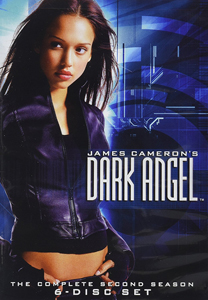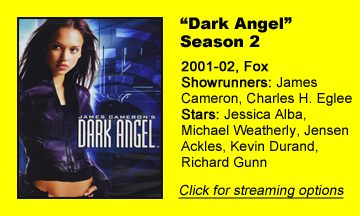For roughly the first half of the season, “Dark Angel” Season 2 (2001-02, Fox) is in a sophomore slump to match the inevitable ratings slump that goes with Fox’s Friday-night sci-fi dumping ground. Then it remarkably turns things around and closes even more strongly than in Season 1.
Logan (Michael Weatherly) regains his Season 1 hairstyle and glasses, and newcomers Alec (Jensen Ackles) and Joshua (Kevin Durand) finally get episodes that make them fully realized members of the hero team.
Initially unfocused
Logan’s new ally Asha (Ashley Scott, later of “Birds of Prey”) never gets such an episode, though, and that’s one of many clues that indicate the writers either changed their minds or were setting the stage for future seasons, not just this one.
Lydecker (John Savage) is supposedly dead, but we know he’s not really, but he doesn’t return from his vehicle crash in episode three.
Ames White (an effectively sneering and slimy Martin Cummins) starts as a pathetic villain – tasked with tracking down and executing the escaped Manticore mutants – but evolves into a more interesting one when we learn he’s part of a breeding cult.
This gives him skin in the game in the buildup to the finale, although it’s always a little strange that a cult that aims for genetic purity loathes Manticore’s X series – like title heroine Max (Jessica Alba) — which is made genetically pure via their births in labs. I guess it’s simple bigotry.
Drawing from ‘X-Men’
“Dark Angel” Season 2 has a lot in common with “X-Men” – the recent series “The Gifted” came to mind a lot on this rewatch – and the weakest episodes are those that heavily draw from that popular franchise (which had jumped from comics to the big screen by 2001).
Max and Logan’s “they can’t be together” dance is solidified by Max’s virus – one last gift from Manticore – wherein Logan will die if she touches him. It’s a hoary device in addition to ripping off the Rogue-Gambit tragedy; that said, I don’t desire lots of scenes of Max and Logan “gettin’ busy,” as Joshua would put it.
Worse than that are the episodes that introduce a mutant, whom White aims to track down, and whom our heroes then rescue from White.
The creature designers usually do a bang-up job creating humans with fish, mule, sand frog, etc., in their cocktails, and dog-man Joshua is a particularly winning design. But the plots of the mutant-of-the-week episodes tend to be similar.
A strong finish
Still, the writing of the overall narrative is tight in the back half, as that “X-Men” (and sadly, real-world) theme of bigotry plays out, often with TV news clips and protesters providing a scope beyond our heroes. Alba has said she likes Season 1 more, but she does professional work here, as does Weatherly.
Durand (later of “The Strain”) is outstanding, and future “Supernatural” star Ackles is a natural smart-alecky talent – even if I had reservations about the presence of both of them.

But what propels “Dark Angel” Season 2 back toward “great” territory is David Geddes’ cinematography. I didn’t notice it so much on my first viewing because I got Fox over-the-air and it didn’t come in crisply.
Watching it on DVD, I think “Dark Angel” might actually make Vancouver and its surroundings look even better than “The X-Files” does. Dimly lit yet colorful (via neon or judicious lighting) alleys, sewers and warehouses – plus Joshua’s homey (in both senses) house – make this show a pleasure to look at.
I wouldn’t want to live in “Dark Angel’s” 2020 rather than the real one (although, admittedly, it’s a closer call than it should be), but I love visiting the post-Pulse world. Here are my rankings of the 21 episodes of “Dark Angel” Season 2:
1. “Dawg Day Afternoon” (episode 18, written by Robert Doherty)
The plot isn’t original; it’s just Joshua and his blind girlfriend Annie (the wonderful Kandyse McClure from “Higher Ground”) being pursued by sector police through the sewers. But the tunnels are delicious, and a bevy of extras on the streets gives full flavor to the accelerating public bigotry against transgenics.
Max, Logan, Alec and even freelance photojournalist Sketchy (the underused Richard Gunn) have parts to play in what is almost “Die Hard in a Sewer.” It’s capped by White upping his Evil game and shockingly murdering Annie, leading to a sweet moment where Alec and Max hug the grieving Joshua.
2. “Harbor Lights” (13, Doherty)
Having forgotten about “Dawg Day Afternoon,” “Harbor Lights” was what I remembered to be my favorite Season 2 hour before this rewatch, and I’d still recommend it as the episode that illustrates “Dark Angel” in its purest form. The new cast members are set aside for a throwback Max-and-Logan hour where she fights her way out of the titular hospital with his outside tech support.
The Max-versus-White showdown is tense while also delivering White’s views on genetic purity, and composer Joel McNeely makes the rooftop helicopter rescue both exciting and moody. Plus, we get a standout Max one-liner to a “nurse” who’s really a cult member: “You’d think after 10 generations of selective reproduction, you wouldn’t have such a fat ass.”
3. “The Berrisford Agenda” (11, Moira Kirland Dekker)
Alec totally turns a corner here as we flash back to his undercover Manticore mission to kill a man named Berrisford. Only he falls in love with the man’s daughter (the beautiful Meghan Ory, in another delightful role for a “Higher Ground” alum), and Ackles gets to show the softer side of his acting chops.
Also featuring a dinner gathering that brings Max, Logan, Alec, Joshua and Original Cindy (the underused Valarie Rae Miller) together, it sets the stage for a much smoother second half of the season for interactions between the main cast.
4. “Brainiac” (10, Chip Johannessen)
As noted, the mutant-of-the-week episodes are generally weak, but this is an exception thanks to a sympathetic turn by Michael Bower as a chubby transgenic who can see specifically into Max’s near future. Understandably, because of his programming, Brain has always been in love with Max, but Bower plays it as bittersweet rather than creepy.
This is also the episode where we get as close as possible to learning about Asha and her anti-establishment group S1W, something that the writers either abandoned after this or shelved until the Season 3 that never happened.
5. “She Ain’t Heavy” (19, Michael Angeli and Doherty)
In a season that already gave us Joshua’s clone and Alec being mistaken for his deceased serial-killer clone, we had to have a Bizarro Max episode, right? Despite the fan-service element, this is a good one that balances funny moments such as Logan thinking he’s seeing Max everywhere (two “Maxes” pass him on motorbikes) with the well-staged showdown between X-452 Max and X-453 Sam.
The hostage exchange at the end is another example of cinematographer Geddes elevating a clichéd sequence into something beautiful, as it features light snowfall in the chilly backstreets.
6. “Exposure” (16, Kirland Dekker)
This is both an important episode and a good one, as Max and Logan venture to a small town and get a good look at White’s breeding cult and its ceremony based on snake’s blood. Plus, Sketchy gets something to do, as he seeks to become a tabloid photographer by snapping pics of mutants.
But, similar to “Harbor Lights,” it’s refreshing that this is mostly Max and Logan doing their old-school investigative teamwork. Callum Keith Rennie is a good character actor, so I wish his sheriff wasn’t so oblivious to the cult’s activities at the school, but Samuel (Devin Douglas Drewitz) is one of the most unusual one-off villains, a kid who can telekinetically throw Max around.
7. “Hello, Goodbye” (17, Jose Molina)
Joshua learns that “love sucks” as he meets Annie but has to let her go for her own safety. And Max and Logan are reminded of the theme in one last instance of Max accidentally touching and hospitalizing Logan. (If it would’ve happened one more time, it would’ve been ridiculous.)
We learn that Transgenic Lives Don’t Matter in Seattle as White purposely releases Mule, who is caught on camera fighting off sector police officers, leading to community outrage against transgenics. “DA’s” 2020 Seattle begins to look like the real 2020 Portland, thus making the series endlessly timely.
8. “Medium is the Message” (9, Angeli)
This is partly a fable episode where Joshua, having been taught that “people fear what they don’t understand,” finds there are good people in the world (an art gallery curator accepts him) and that he can find happiness through painting. I admit Durant is funny when mistakenly eating “chocolate” paint or stumbling over precious artworks, even if I’ll never be completely sold on “DA” including broad comedy.
It’s also partly a mythology episode, and one that effectively switches gears by revealing White’s status as a genetic pureblood, even if the idea of White having a side life as a family man (with an oblivious wife) is jarring.
9. “Boo” (5, Charles H. Eglee and Kirland Dekker)
This not-totally-successful Halloween episode is by far the best of the early episodes because it tries something different. Maybe I should be ashamed that I didn’t realize until the final act that it’s all Max’s dream, but it’s ultimately an amusing hour where we get a glimpse into Max’s fears – including the notion of Logan and Asha being a couple. (As such, Asha gets her biggest role of the season in a dream sequence.)
The writers are generally good about giving J.C. MacKenzie’s Normal a good comic-relief thread, and here’s a prime example as he has a sneezing fit around a cat-woman.
10. “Freak Nation” (21, Ira Steven Behr and René Echevarria)
I have mixed feelings about “Dark Angel’s” epic 1-hour-and-3-minute finale, which I assume ranks higher on most fans’ list. It’s undeniably a slick and pricey James Cameron-directed yarn with a satisfying final moment of the transgenics raising their flag in Terminal City.
All of the main characters (except the forgotten Asha) are well-served, including Normal, whose bigotry ends when he delivers a beautiful X-5 child. (In another fun Canadian-actor cameo, “Being Erica’s” Erin Karpluk plays the mother.) But everything in the episode is rather expected and familiar, as it’s centered on a hostage standoff at Jam Pony.
11. “Love in Vein” (14, Angeli)
Among the freak-of-the-week eps, I don’t mind this one too much. Sam Witwer (Darth Maul on “The Clone Wars”) is good as a reverse-vampire, a rare Manticore escapee who is bad at heart. The design of Marrow, with his veiny face and the way he feeds his blood to his indentured acolytes, is creepy.
And the cult is vastly more interesting than the cheesy Steelheads (who intentionally give themselves robot prosthetics) from the season’s first half. This is a predictable hour, but a stylish and enjoyable one.
12. “Love Among the Runes” (20, Molina and Kirland Dekker)
Despite being an info-dump wherein the transgenics prepare for war in Terminal City, this yarn also rushes the overall narrative. For example, out of nowhere we meet Biggs, a transgenic Jam Pony worker who is tight with Alec. The scene of Alec and Joshua beating up bigots has some power, and White’s tactic of recognizing transgenics with body-temperature scanners is another nice parallel to the real 2020.
White’s “crazy” brother C.J. (Henri Lubatti) is almost entertaining, and the fact that White and C.J. are the sons of mysterious geneticist Sandeman (who we never actually meet) is almost interesting, but these revelations don’t really change anything.
13. “Fuhgeddaboudit” (15, Julie Hess)
This high-concept episode should be better, but it is something different, so I can’t hate it too much. Tracy Ryan is delightful as sweet-voiced Mia, who practices “telecoercion” – she can make people do things or erase their recent memories. This rare brightly lit hour gets a little long in the tooth, though, as it keeps going back to the well of Alec taking on opponents (including Max, inevitably) in a fight ring and Normal racking up winnings. Ultimately, it’s a mildly amusing hour.
14. “Some Assembly Required” (7, Doherty)
It wasn’t strictly necessary to bring back Zack (William Gregory Lee, now with a partially prosthetic face that calls to mind Adam from “Buffy”), but the way Doherty gives him a happy, mind-wiped ending is rather clever. Before that, this is a flat hour wherein Zack’s romantic feelings for Max are played neither for comedy nor awkwardness.
But it is nice to address the one-way-romance, since it was an unspoken, maybe even accidental element of Season 1, as we’re reminded in flashback clips. All attempts at comedy fail: The Steelheads are the Three Stooges without laughs, and even Normal’s fear of Max being dangerously violent isn’t funny.
15. “Two” (6, Molina)
This is an OK Joshua episode, as he strives to protect his confused brother Isaac, who of course has no chance against the cops since he’s both a mutant and psychologically troubled. The predictability hurts the story, although Durand is good in dual roles. It’s nice to see a friendship bud between Alec and Sketchy, and Ackles is amusing when talking on his cellphone while simultaneously fighting off Steelheads. In a fun wrong prediction of the future, Max and Alec steal Sammy Sosa’s 2009 home run ball that broke Hank Aaron’s record.
16. “Proof of Purchase” (3, Tommy Thompson)
This is an important episode in the early, shaky relationship between Max and Alec as he can’t bring himself to kill her and she can’t help but save his life. Although the Sandeman mystery makes no sense at this point, it is moving forward: Lydecker is (supposedly) murdered after finding ancient runes with Manticore’s lion symbol. The writers would practically forget that they did this episode and instead re-introduce the runes much later. So it’s an interesting false start, I suppose.
17. “Bag ’Em” (2, Marjorie David)
It’s cute that Max takes charge of a group of young Manticore escapees and gives them names (much to their confusion). At this point, White is a lame bad guy who rounds up mutants and makes sniveling faces. When Max says “So you’re the new bad guy in my life,” it brings up comparisons to Lydecker that White can’t win (although by season’s end, he’ll narrow the gap). This is a rote but impersonal repeat of those Season 1 stories where Max saves her X-5 friends, although it does feature her best-ever excuse for missing work, as she shows a flustered Normal her scar from open-heart surgery.
18. “Radar Love” (4, Angeli)
This episode tries and fails to sell the notion that Max-and-Rafer (Kris Pope) and Logan-and-Asha are possible romantic outcomes. A highlight is a multi-screen, multi-phone-conversation involving the quartet. We don’t believe for a second that these relationships are likely; that’s the curse of the Max-Logan chemistry.
The good thing is that the writers watched this episode and came to the same conclusion, and they mostly abandon love triangles (or rectangles) — except when Max briefly, and absurdly, convinces Logan she’s with Alec later in the season. The disease outbreak plot is another unfortunate parallel to the actual 2020.
19. “Designate This” (1, Kirland Dekker)
The season gets off to a bad start as a two-parter is crammed into one hour (Fox rejected the request for a two-hour premiere). It’s somewhat like “Buffy’s” “Anne” in that Max reclaims her identity (“My name is Max”) after a summer of Manticore abuse and brainwashing, but with none of the feeling. Alec and Joshua are effectively introduced, but there’s nothing at this point that makes me want more of them at the expense of the Jam Pony gang.
Asha debuts, but there’s no time to even give her a name. A bunch of Manticore subjects are loose, but it’s not sold visually, as there aren’t enough extras in the sequence. Max and Logan can’t touch. And all the while I’m wondering how in the world Max managed to get a stylish new hairstyle at a military indoctrination camp.
20. “Gill Girl” (8, David)
This is just an hour of Max and company rescuing a fish-girl and fish-guy from White. There’s room for humor in the teleplay, with Normal being at a strip club, and with Max pretending to give Alec a lap dance. It’s all unfunny and awkward (but not in a good way) because you can only do so much on TV, and Alba (or Max, or maybe both) isn’t into selling the sexuality-laced humor.
21. “Borrowed Time” (12, Molina)
Although it comes amid a surge of good episodes, this particular one is the season’s clear low point. It’s a short story expanded into a novel, as Max and Logan can touch for a limited period, but they’re pulled into a case and miss their chance to “get busy” and now feel even worse. By being heavy-handed, the tragedy becomes corny. And it doesn’t help that we get the worst practical effects of the series.
Although I like the design of the web-spitting Gossamer, the creature is portrayed with rapid editing to hide the shoddiness of the costume. Plus, it’s supposed to hold our heroes in webbing like the xenomorph’s in “Aliens,” and it’s utterly unconvincing. We get another fun wrong prediction here, as “Star Wars: Episode VII” went unfinished thanks to the pulse of 2009, and a rough cut goes for $20K on the black market.
How do you rank the 21 episodes of “Dark Angel” Season 2? Share your list in the comment thread below.


